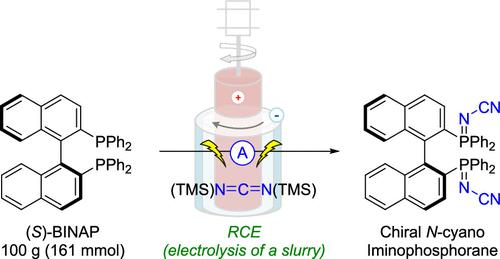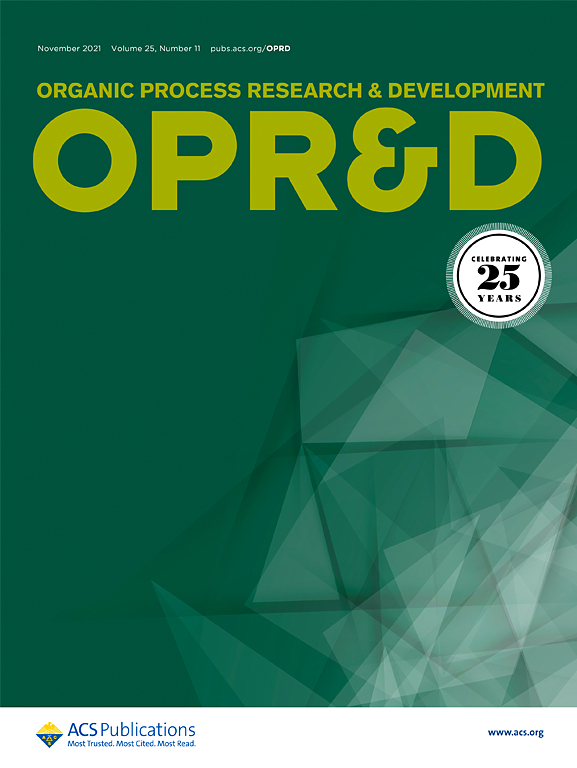A Scalable Flow Electrolysis of Heterogeneous Mixtures Using a Rotating Cylinder Electrode Reactor: Access to a Chiral Iminophosphorane
IF 3.1
3区 化学
Q2 CHEMISTRY, APPLIED
引用次数: 0
Abstract
We report the application of rotating cylinder electrode (RCE) reactors for the electrolysis of heterogeneous reactions in batch and in recirculating flow. A scalable method for the synthesis of an N-cyano iminophosphorane ligand in an RCE reactor is also reported. In the development of this process, a graphite felt attached to the inner impervious graphite was used as a rotating anode, and the outer stainless steel wall of the reactor was used as the cathode. The reaction was first evaluated in batch using a small RCE reactor to optimize the spinning rate, supporting electrolyte, and current density. The optimal batch condition was then scaled up in a medium-sized RCE reactor with modifications to adapt it to a flow process. The electrosynthesis was demonstrated up to a 100 g scale, and the impact of the reaction temperature was investigated. Finally, an operationally simple direct crystallization using water as the antisolvent provided a chiral N-cyano iminophosphorane ligand in 74% isolated yield on a 100 g scale from commercially available (S)-BINAP and bis(trimethylsilyl)carbodiimide.

使用旋转圆柱电极反应器的非均质混合物的可扩展流动电解:获得手性亚磷烷
本文报道了旋转圆柱电极反应器(RCE)在间歇式和循环流非均相反应电解中的应用。本文还报道了一种在RCE反应器中合成n -氰亚磷烷配体的可扩展方法。在该工艺的开发过程中,用附着在内部不透水石墨上的石墨毡作为旋转阳极,用反应器的外部不锈钢壁作为阴极。该反应首先在一个小型RCE反应器中进行批量评估,以优化旋转速率、支撑电解质和电流密度。然后在中型RCE反应器中进行了优化,使其适应于流动过程。在100 g范围内进行了电合成实验,并研究了反应温度的影响。最后,以水为反溶剂进行操作简单的直接结晶,从市售的(S)-BINAP和双(三甲基硅基)碳二亚胺中分离出手性n -氰基亚磷烷配体,收率为74%。
本文章由计算机程序翻译,如有差异,请以英文原文为准。
求助全文
约1分钟内获得全文
求助全文
来源期刊
CiteScore
6.90
自引率
14.70%
发文量
251
审稿时长
2 months
期刊介绍:
The journal Organic Process Research & Development serves as a communication tool between industrial chemists and chemists working in universities and research institutes. As such, it reports original work from the broad field of industrial process chemistry but also presents academic results that are relevant, or potentially relevant, to industrial applications. Process chemistry is the science that enables the safe, environmentally benign and ultimately economical manufacturing of organic compounds that are required in larger amounts to help address the needs of society. Consequently, the Journal encompasses every aspect of organic chemistry, including all aspects of catalysis, synthetic methodology development and synthetic strategy exploration, but also includes aspects from analytical and solid-state chemistry and chemical engineering, such as work-up tools,process safety, or flow-chemistry. The goal of development and optimization of chemical reactions and processes is their transfer to a larger scale; original work describing such studies and the actual implementation on scale is highly relevant to the journal. However, studies on new developments from either industry, research institutes or academia that have not yet been demonstrated on scale, but where an industrial utility can be expected and where the study has addressed important prerequisites for a scale-up and has given confidence into the reliability and practicality of the chemistry, also serve the mission of OPR&D as a communication tool between the different contributors to the field.

 求助内容:
求助内容: 应助结果提醒方式:
应助结果提醒方式:


